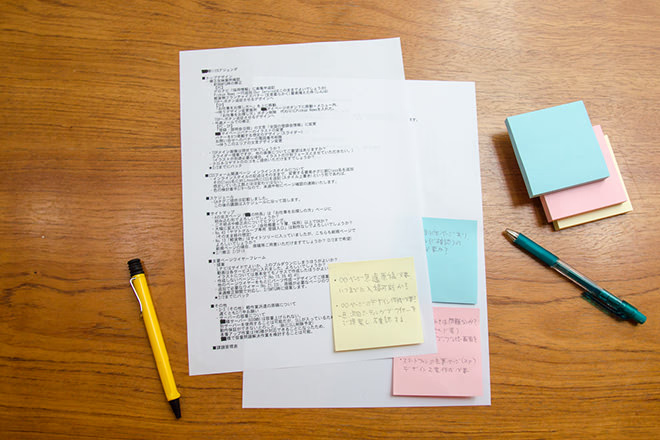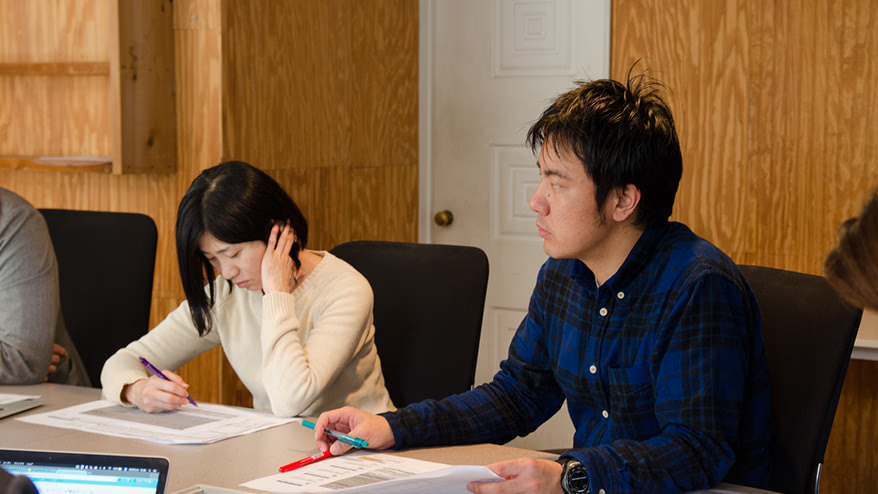こんにちは、ディレクターの大藪です。
案件を進める上で必要なクライアントとのミーティングですが、議題の決定や資料作成、ミーティングの司会進行まで行うことも、ディレクターの大きな役割です。
今回は、普段私がミーティングに向けて考えていることや、ミーティングの進め方についてお話ししたいと思います。
状況によって変化する
ミーティング内容

以前こちらのコーナーでお話しさせていただいた『スケジュール表の作り方』の中でも、ミーティングについて少しだけ触れました。案件スタート時に作成するスケジュールに沿ってミーティングが予定されるわけですが、ミーティングで議題とすべき細かい内容は、案件が進む中で徐々に決まっていきます。
例えば、デザイン提案を行うミーティングがあったとします。
前行程のワイヤーフレーム提案時に「デザインをみて決めさせてほしい」と要望があった場合は、その部分について中心に話し合ったり、コーディング時に実装する動きの説明が必要になります。
また、提案したデザインが通らない時は、修正箇所についてヒアリングを行い、スケジュール調整をする必要も出てきます。
案件の状況によって、提案の方向性や内容を臨機応変に決めなければなりません。実際に会ってその場でクライアントと状況を共有し、提案や相談ができるという点で、ミーティングは必須だと考えています。
ただし、いくらミーティングを行っても、その場で話すべきことをしっかり決めておかなければ意味がありません。今この案件ではどんな課題があるのか把握し、議題とするための事前準備をしておく必要があります。
課題が議題になる
案件には課題がつきものです。
私はそれぞれの案件で、制作側とクライアント共有の課題管理表を必ず作ります(詳しくは『スプレッドシートを使った、ディレクターのための課題管理表』参照)。案件が進むにつれ課題は増えていき、ピーク時はやるべき細かいことが毎日いくつも発生します。頭の記憶だけでは全ての課題を維持できず、課題管理表無くしてディレクターは勤まらないと思うほどです。

スプレットシートでつくった課題管理表をミーティング用に印刷したもの。今ある課題を見直し、優先して解決するものなど整理している。
発生した課題を管理表に追加していくのですが、同時にその課題が、すぐに解決できるものなのか、クライアントに動いてもらう必要があるのか、スケジュールを調整する必要があるのか、など、いつ・誰が・何をすればよいか考えます。
そうやって課題1つ1つのゴールを見据え、すぐに解決可能なものと、すぐ解決できず継続するものに整理していきます。
そして、継続する課題はミーティングの議題候補になります。
例えば、入稿スケジュールにない原稿制作を急遽クライアントにお願いする事態が発生した場合、どんな内容の原稿になるか、入稿はいつになるのかということは、電話やメールよりもミーティング時に確認したほうがよいでしょう。
このように、課題が発生すると同時にミーティング時の議題も決まってゆくのです。
ただし、課題が多くなってきた場合、今ある継続課題を全て次回ミーティングの議題にしようとすると、1度に決めることが多くなり過ぎ、逆に効率の悪いミーティングとなってしまいます。
スケジュールを確認し、課題の優先度を決め、次回のミーティングで議題にすべきものと課題管理表に一旦残しておくものを決めることも必要です。
ミーティング資料はあらかじめ提出しておく
ミーティング資料として毎回必ずアジェンダを作成します。
アジェンダには議題と、議題に対しての区分(説明・提案・確認)、担当者、所要時間を記載します。誰が何を話すか明確にでき、その日決めることなどの目標を定めるためにも、アジェンダ作成は必須だと考えています。
アジェンダや提案物はミーティング前日にクライアントに提出するようにしています。事前に議題を確認してもらうことで、クライアント側で準備ができるからです。準備といっても、なにか資料などつくってもらうのではなく、例えば「回答する準備」などしていただきます。
ミーティング当日にいきなりデザイン提案して、その場で確認してもらい回答を待つよりスムーズになります。
また、当日のミーティング内容をクライアントがイメージしやすいよう、議題は「デザイン提案 ○○ページ」など、なるべく具体的に記載するようにしています。
また、ミーティング時間を予定することも大事です。
話し合うこと、決めなければならないことの準備をして、決めた時間通り議題を進めることで無駄な時間を無くし、より効果的なミーティングを行うよう心がけています。
「カンペ」は未来の課題リスト
ミーティング時、1つの議題から新たな課題が発生することもあります。
例えばよくあるのは、提案内容の修正が必要になった場合です。この場合、「制作側はいつまでに修正対応するか」「クライアントがいつ再確認を行うか」という2つの課題が発生します。こういった予期できることは、その場で決めてしまいたいものです。
そこで私が用意するものは自分専用の「カンペ」です。その名の通り、ミーティング時に自分だけチラチラと見るものです。

ミーティング司会を行う為のカンペ。ミーティング直前はこれを読み返してイメトレもします。
「〜〜の修正が発生した場合、○日までに修正するので、○日までに再確認希望」などと各議題から発生しうる課題とネクストアクションを予想してメモを残しておくことで、ミーティング後に改めてスケジュールを見直す時間をかけることなく、その場で解決したり予定を決めやすくなります。
わかりやすい課題はすぐ課題管理表に記載することができますが、課題が発生した時点でやることが全て明確に決まっているわけではありません。
そういった、まだ課題としてあげられないが、のちに重要度が高くなりそうなことは、日々メモとして残しておき、ミーティング準備の際、「カンペ」に落とし込みます。
日々のメモ書きも、ミーティングを行うための大切な準備なのです。
まとめ
クライアントとのミーティングは貴重な時間だと考えています。案件の流れや状況を考え、厳選した議題を立ててミーティングにのぞんでいます。
また、ミーティング進行中も限られた時間内でちゃんと話しをまとめられるように、準備も怠りません。
案件が中盤に入ると、課題も増え、次のミーティング準備に追われてしまうことも多々ありますが、実のあるミーティングができるととても充実した気持ちになります。

